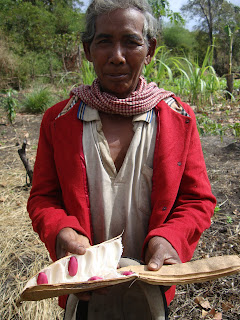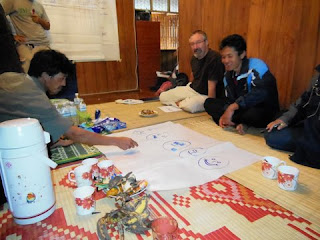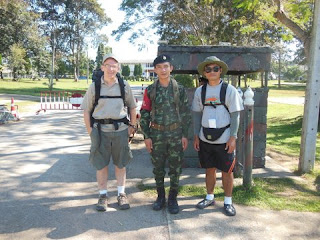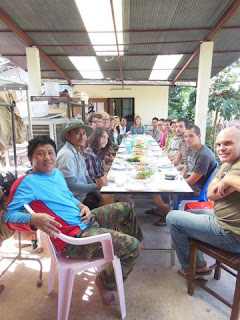Cambodia's Tonle Sap Lake is the largest freshwater lake in Southeast
Asia. During most of the year, the lake is fairly small with depths of
about one meter deep and an
area of 2,700 square km. However, during the rainy season, overflow
from the Mekong River causes the lake to swell to 15,000 square km with a
depth up to nine meters (Wikipedia,
http://en.wikipedia.org/wiki/Tonl%C3%A9_Sap).
Thousands of families, many of whom are ethnic
Vietnamese, live year round on houseboats, making their living from
fishing. Even more Khmer communities are located in the floodplain of
the Tonle Sap.
Most of the year, when the lake is low (roughly
November through July), these floodplain communities are located on dry
land. However, homes are built up high on stilts that are several
meters tall in preparation for the annual rise of the lake.
During a recent dry season visit to some of these
Tonle Sap floodplain communities near Siem Reap, we learned that planks
used for floors in these homes can be adjusted higher depending on the
water levels.
During the dry season, the residents of the
floodplain communities continue to catch fish from the lake to sell,
generally preserving their catches through drying,smoking or
fermentation. But many also supplement their food and income by raising
vegetable gardens in the organic matter rich soil around their homes.
Luffa gourd, with edible fruit and shoots, and eggplant the most
commonly grown vegetables in these gardens. And water spinach (Ipomoea aquatica) grows in practically all moist locations.
In addition to the dry season garden patches, most
of the elevated households also had container gardens. Small plantings
of herbs and vegetable, as well as papayas, are grown in various types
of containers, allowing for production even when the lake again
surrounds the houses. The frequency and extent of container gardening
among these Tonle Sap households was greater than any other complex of
communities that I have visited.
We also observed that some families also have
pigpens located beneath their houses. They generally feed their pigs
cooked water spinach, rice bran and food scraps. Interestingly, it was
explained to us that some of the pigpens were actually pig rafts, under
which drums are attached for flotation when high waters eventually
return.
As the water table in the flood plain is quite high,
access to water for irrigating small garden patches and watering pigs
isn't much of a problem. However, the dirty water is also used for
other household purposes, such as washing dishes, laundry and drinking water. Of course, waterborne disease is a major concern since, as our guide reported, many of the residents do not either
boil or filter their water. Fortunately, one home that we visited had a
ceramic water filter that does an excellent job of filtering dirt,
debris and bacteria from the water.
Although the Tonle Sap supports the aquatic
livelihood of many thousands of Cambodian families, it is a challenging
environment in which to live and work, requiring adaptability and
resilience by the locals.
But perhaps the greatest challenge
for the Tonle Sap ecosystem and its human residents will be the effects
of 42 dams that are proposed to be built along the Mekong and its
tributaries that would inevitably affect the flow of water into this
natural wonder. In addition, the effects of climate change are expected
to bring greater variation to the water levels of the Tonle Sap, as
well as changed seasonal shifts in water level patterns.
Therefore the already resilient
communities of the Tonle Sap may need even more adaptability and
preparation for a very uncertain future.






























































